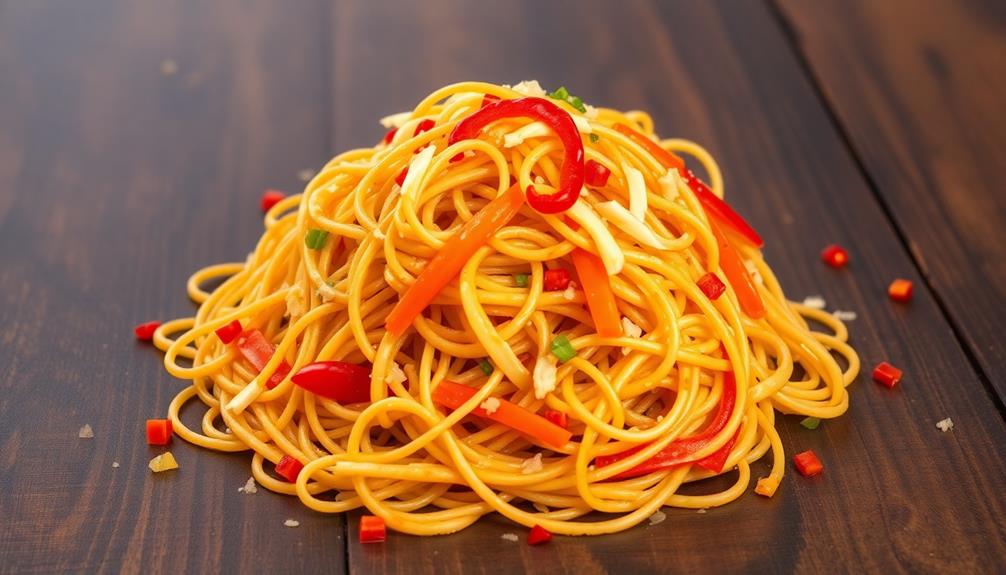Dining etiquette has evolved greatly over time, showcasing humanity's changing values. From ancient communal meals in Greece that emphasized respect to the chivalric manners of the 11th century, each era influenced the standards we follow today. The Renaissance introduced elegant table settings, while the 18th century standardized cutlery and course structures. Modern dining embraces diverse preferences, prioritizing inclusivity and casual interactions while maintaining threads of tradition. You'll find fascinating details on how these customs shaped our culinary experiences and what they mean for your next meal if you explore further.
Key Takeaways
- Dining etiquette has roots in ancient civilizations, evolving from simple communal practices to complex social rituals emphasizing respect and order.
- The Renaissance introduced elaborate table settings and fine china, elevating dining to a sophisticated art form reflecting societal status.
- The standardization of cutlery and place settings in the 18th century shaped modern dining practices and established formal etiquette.
- Cultural rituals, such as communal dining and specific meal customs, have historically influenced dining etiquette and social interactions.
- Modern dining practices reflect a shift towards casualness, inclusivity, and personal preferences, accommodating diverse dietary needs and styles.
Historical Context of Dining Etiquette

What influences have shaped dining etiquette over the centuries? The roots of dining etiquette trace back to ancient civilizations, where social rituals around meals were essential. The Ancient Greeks documented early practices, emphasizing respect and order during communal dining.
By the 11th century, European dining manners began to emerge, intertwined with chivalric traditions that formalized social interactions at the table. In Brazil, the rich culinary landscape influenced by regional variations also shaped communal dining experiences, highlighting the importance of shared meals in social gatherings.
The Renaissance brought about a significant shift, introducing elaborate table settings and the widespread use of fine china, which reflected the increasing sophistication of social customs.
As the 18th century rolled in, standardized place settings became the norm, with specific utensil placements and multiple courses shaping what we now consider modern dining practices.
Throughout these centuries, dining etiquette has continually adapted, merging historical customs with modern sensibilities. You'll find that what was once considered polite can evolve, influenced by the changing dynamics of society.
Today's dining etiquette often reflects a blend of these traditions, reminding us that our table manners carry the weight of history while embracing contemporary values.
Greeting and Respectful Gestures

When you greet guests, standing up shows your respect, especially for women and dignitaries.
It's a simple yet powerful way to acknowledge their presence and set the tone for the gathering.
For instance, understanding the significance of traditional dishes like Kedjenou can enhance your dining experience and reflect your consideration for others.
Understanding historical customs around seating and greetings can enhance your dining etiquette and reflect your consideration for others.
Historical Greeting Practices
Throughout history, greeting practices have played an essential role in setting the tone for social interactions, especially during dining occasions. When you welcome guests, standing to greet them, particularly women and dignitaries, shows respect and attentiveness. This traditional etiquette emphasizes humility and creates a warm atmosphere.
The importance of sharing traditional foods, such as Horiatiko Psomi, reflects the cultural significance of hospitality in various societies.
In the 19th century, etiquette literature, such as "The Gentleman's Book of Etiquette," stressed that you should remain standing until all guests are seated. This practice underscores the importance of acknowledging your guests upon arrival, a critical aspect of dining etiquette that still resonates today.
Moreover, waiting for ladies to be seated before taking your own seat exemplifies traditional respect in social settings. The way you greet your guests can set the entire dining experience's tone, reflecting your demeanor as a host.
Importance of Standing
Standing to greet guests is a powerful gesture that embodies respect and attentiveness, essential in any dining setting. This longstanding tradition highlights the importance of hospitality and reflects historical customs ingrained in etiquette. When you stand to welcome your guests, you're acknowledging their presence and demonstrating humility, especially towards women and dignitaries.
Here's a quick look at the significance of standing in dining etiquette:
| Gesture | Meaning | Historical Context |
|---|---|---|
| Stand to greet | Shows respect and attentiveness | Rooted in 11th century European customs |
| Remain standing | Displays humility | Emphasized in "The Gentleman's Book of Etiquette" |
| Wait for ladies | Acknowledges gender-specific nuances | Highlighted in 1860s etiquette literature |
| Stand until seated | Reinforces hospitality | Reflects hierarchical nature of social interactions |
In formal dining settings, such gestures reinforce the importance of respecting your guests. By adhering to these customs, you honor a tradition that has shaped dining etiquette through the ages. Embrace these practices to enhance your dining experiences and foster respectful interactions.
Respectful Seating Customs
Respecting seating customs is essential in creating an inviting atmosphere during any dining experience. When you embrace these practices, you show appreciation for both the hosts and guests alike. Incorporating festive dishes like Graveyard Taco Dip can also enhance the dining experience, adding a fun element to the meal.
It's customary for hosts to stand until all guests are seated, a gesture that underscores the importance of respect and honor. This tradition also emphasizes the need for humility, particularly towards women and dignitaries.
Historical etiquette literature, like "The Gentleman's Book of Etiquette," highlights the significance of standing until women are seated, showcasing long-standing customs of respectful behavior.
As a host, your seating arrangements should prioritize the comfort and status of your guests. Placing elderly guests and couples in proximity can enhance their experience, ensuring ease and companionship during the meal.
Proximity to you, the host, at the dining table often signifies a place of honor, further elevating the dining experience.
Fine China and Dinnerware
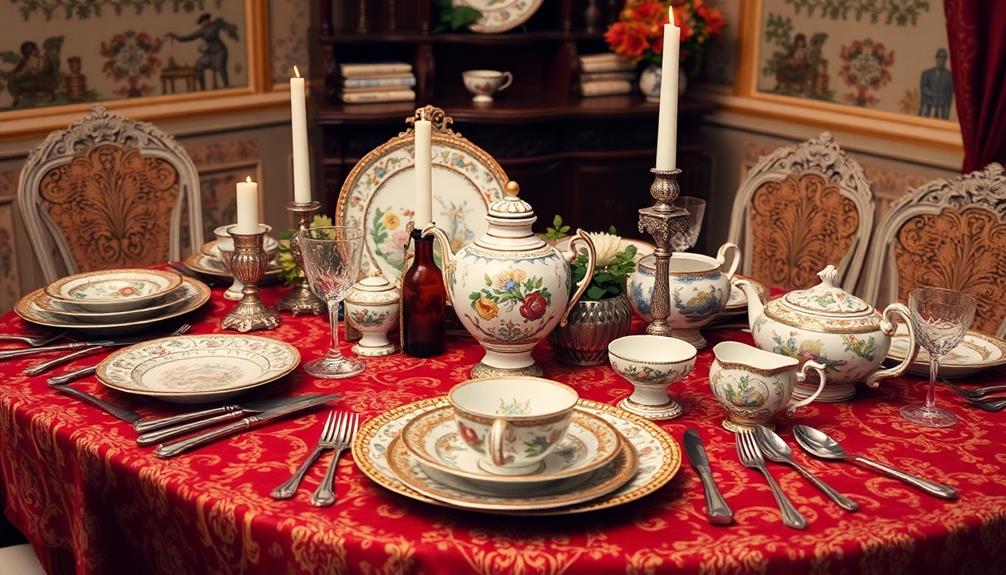
Fine china, with its roots in China, represents luxury and sophistication in dining.
The rich culinary traditions, such as Red-Braised Pork Belly, often feature beautifully presented dishes that complement the elegance of fine china.
You'll find that the craftsmanship behind these exquisite pieces not only highlights the skill of artisans but also adds to their collectibility and value.
Today, you may notice evolving trends in how fine china is used, making it relevant in both formal and modern dining experiences.
Origins of Fine China
Originating from the exquisite art of porcelain-making in China during the Tang Dynasty (618-907 AD), fine china has captivated collectors and enthusiasts alike. This remarkable material is celebrated for its beauty and durability, making it a preferred choice for special occasions.
The term "china" itself reflects the European fascination with this porcelain, which they sought to replicate in the 18th century using local clay and techniques. As dining evolved, so did the presentation of food, resembling the artistry found in traditional Italian dishes like pasta with tomato sauce that emphasize simplicity and quality ingredients.
As you explore the history of fine china, you'll find that European derivatives like Meissen and Wedgwood emerged, showcasing intricate designs and artisan expertise. These pieces not only reflect a dedication to craftsmanship but also serve as symbols of tradition and rules in formal dining settings.
Among the most collectible forms of fine china are tea service sets, which highlight the historical significance of tea culture in both Eastern and Western societies.
Collectors often seek antique sets, valuing their rarity and the stories they tell. Each piece you encounter carries a legacy, inviting you to appreciate the artistry and the cultural heritage that fine china represents in table services and settings around the world.
Craftsmanship and Collectibility
The allure of fine china and dinnerware lies in the meticulous craftsmanship that goes into each piece, making it a treasured addition to any table setting. Fine china, originally celebrated for its delicate appearance, represents the pinnacle of artisan expertise. The production process often involves multiple firings and glazing techniques, resulting in intricate designs that captivate collectors and enthusiasts alike.
Many elegant dining experiences, such as those featuring Mushroom Masala, are often enhanced by the presentation on fine china, showcasing the beauty of both the food and the dinnerware.
European derivatives of Chinese porcelain emerged in the 18th century, creating iconic patterns like Blue Willow and Spode's transferware that continue to hold historical significance. These designs not only enhance the aesthetic appeal of dinnerware but also reflect the social status of their owners.
Elaborate table settings featuring fine china have long been associated with wealth and refinement, making them highly sought-after collectibles.
Among the various pieces, tea service sets stand out, often fetching high prices at auctions due to their artistry and cultural importance. Collecting fine china isn't just about ownership; it's about preserving a piece of history and appreciating the craftsmanship that brings beauty to your dining experience.
Owning such dinnerware allows you to connect with centuries of tradition while elevating your own table settings.
Modern Uses and Trends
In recent years, fine china and dinnerware have evolved to meet modern tastes while still honoring tradition. You'll find that formal table settings now blend traditional values with modern aesthetics. The elegance of fine china is still celebrated, but you can expect innovative designs that appeal to contemporary sensibilities.
For instance, many chefs now embrace farm-to-table cooking principles, which emphasizes the importance of seasonal ingredients and sustainable practices, influencing how fine dining is approached. Consider these trends in fine china and dinnerware:
- Sustainable materials: Many brands are prioritizing eco-friendly options, so you can enjoy luxury without compromising the environment.
- Minimalist designs: Sleek, simple patterns make fine china more accessible for everyday use, enhancing your dining experiences.
- Personalized tableware: Customization allows you to express your style while maintaining the etiquette of a formal arrangement.
The careful arrangement of dinnerware remains essential in fine dining, adhering to etiquette that includes proper placement of charger plates and utensils. This attention to detail not only elevates your meals but also reflects a commitment to craftsmanship.
Seating Arrangements and Guest Placement

Seating arrangements at dining tables have long been a reflection of social dynamics and cultural norms, where hosts carefully consider guest placement to convey respect and hierarchy. Historically, you'd find hosts dictating these arrangements based on etiquette, ensuring guest comfort while maintaining social hierarchy. Honored guests were often seated near the host, indicating their importance.
In Spanish dining culture, for example, sharing dishes like Sepia a La Plancha emphasizes communal eating and connection among guests, which can also influence seating choices. Couples were placed together to foster companionship, while elderly guests received thoughtful placements for ease of mobility. The proximity to the host symbolized a place of honor, much like how saltcellars once denoted significance at the table.
Dining traditions emphasized the importance of guests, with hosts often remaining standing until everyone was seated, showcasing respect and attentiveness, particularly towards women and dignitaries.
Today, while seating arrangements may lean towards more casual settings, the essence of these practices remains. You still see elements that reflect respect and acknowledgment, ensuring that your dinner parties are both enjoyable and reflective of social nuances.
Thoughtful host placements and table settings can create an atmosphere where everyone feels valued, reinforcing the significance of each guest in the dining experience.
Evolution of Cutlery
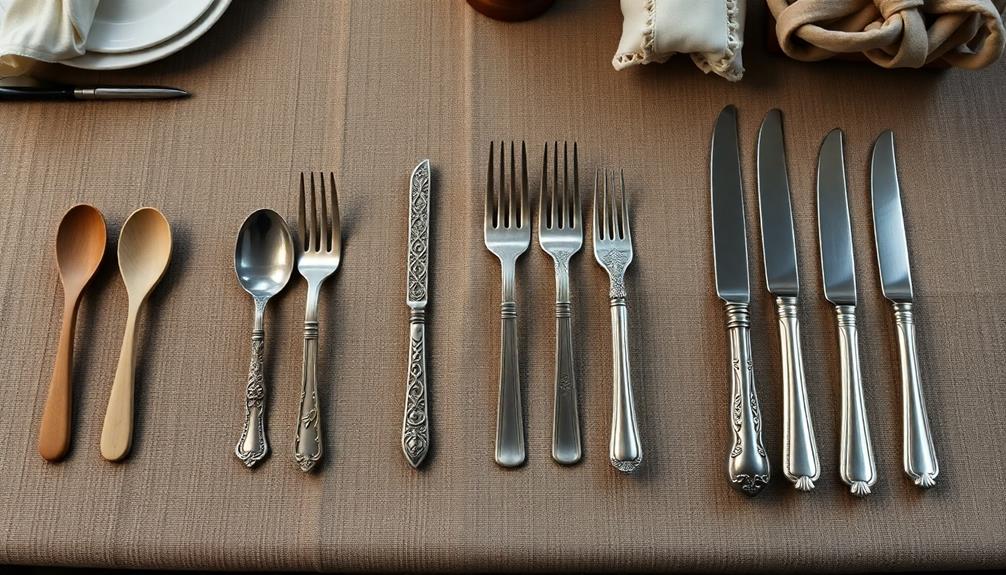
Transforming the dining experience, cutlery has evolved considerably over the centuries, reflecting changes in culture and social norms.
You might be surprised to learn that spoons with handles date back to ancient Egypt around 1000 B.C., primarily used for religious purposes. Knives, initially both utensils and weapons, raised safety concerns, prompting their dulling by the 16th century for safer table use.
In Japan, traditional dining also incorporates unique utensils and dishes, such as the delicate presentation of Dorayaki (Red Bean Pancake), showcasing how cultural elements influence dining practices.
Forks gained traction in Europe during the 16th century, thanks to Catherine de Medici, and became commonplace by the 18th century, featuring curved tines to improve functionality.
Key aspects of cutlery evolution include:
- The standardization of cutlery placement, with forks on the left and knives and spoons on the right.
- The growing emphasis on dining etiquette, shaping modern table settings.
- The shift towards casual dining experiences, leading to simplified cutlery and sustainable tableware choices.
Today, as you set your table, remember how these dining traditions have shaped your cutlery choices.
The evolution of spoons, knives, and forks not only defines your dining experience but also reflects centuries of cultural development.
Cultural Rituals and Meals
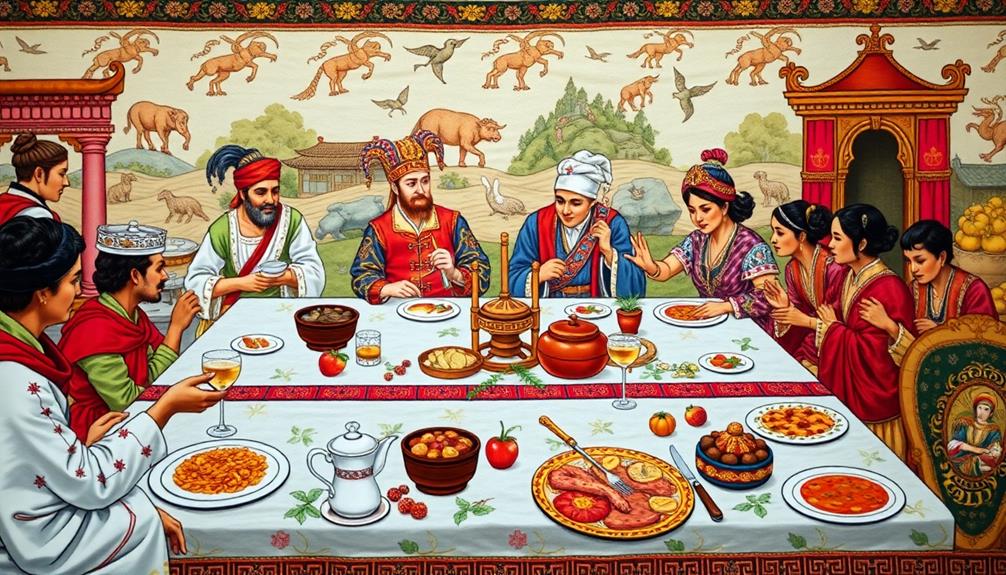
Cultural rituals surrounding meals have shaped the way people gather and interact throughout history. These rituals, like the 18th-century English tea time, emerged as stylized practices that emphasized polite manners and enhanced social interaction. Such dining experiences reflect the cultural significance of sharing meals together, reinforcing social relationships and community bonds.
In many cultures, communal dining—especially in Middle Eastern settings where flatbreads play a central role—defines identities and deepens connections among individuals. You might notice that 18th-century paintings often highlight tea time, showcasing its importance in shaping etiquette and social norms. These artworks remind us that food consumption isn't just about sustenance; it's also a means of fostering relationships.
Formal dining practices have evolved from these rituals, incorporating multiple courses and specific utensils that you may still encounter in upscale restaurants today. They showcase a blend of tradition and modern dining culture, emphasizing the importance of etiquette.
Modern Dining Practices
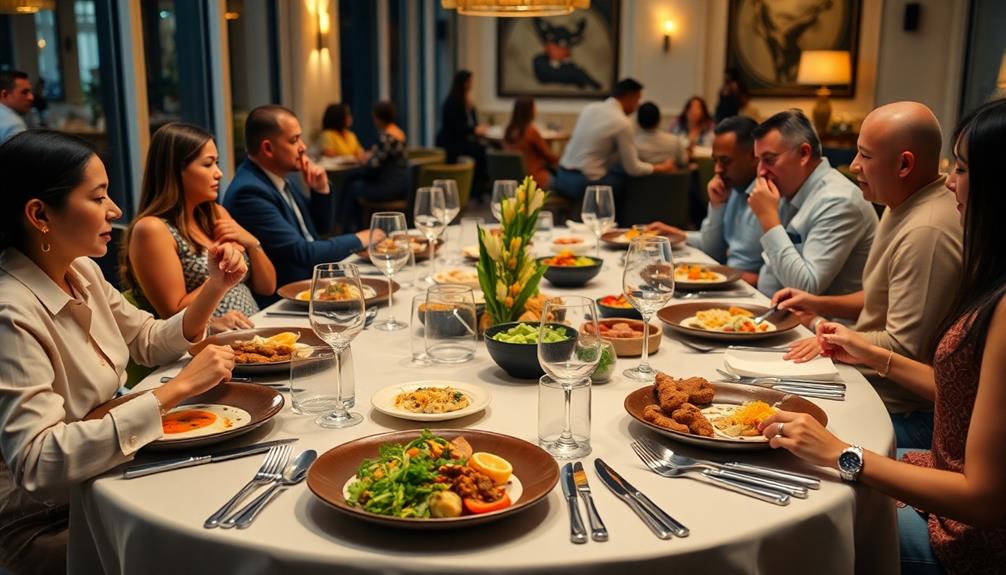
Modern dining practices have evolved considerably, reflecting changes in lifestyle and social norms. The shift towards casual dining means you're likely to enjoy finger foods like burgers and pizza more often than formal multi-course meals. While formal dining still has its place for special occasions, fast-food culture has taken over much of our everyday eating habits.
Today's dining etiquette prioritizes personal preferences and inclusivity, accommodating various dietary restrictions. You might find that menus are increasingly tailored to meet diverse needs, ensuring everyone feels welcome. Restaurants are also using technology to enhance the dining experience, with the impact of augmented reality becoming more prominent. This allows for interactive menu displays and virtual 3D images of dishes, helping customers make more informed and personalized choices. As dining etiquette and technology continue to evolve, the focus remains on creating a welcoming and tailored experience for all patrons. The impact of AR on menus goes beyond just providing information about the dishes. It also allows for greater creativity in presenting the menu and enhancing the overall ambience of the restaurant. With the ability to showcase visually stunning and interactive menus, AR can elevate the dining experience and leave a lasting impression on customers. As the dining industry continues to embrace technology and prioritize inclusivity, the impact of AR on menus will undoubtedly play a significant role in shaping the future of dining etiquette.
Technology has also transformed how we gather, with virtual gatherings becoming common, often influenced by social media trends in dining presentation.
Key aspects of modern dining practices include:
- Minimalism: Expect simpler table settings, often with bare tables or placemats instead of traditional tablecloths.
- Casual Atmosphere: Dining is less about strict rules and more about enjoying the experience.
- Focus on Quality: There's a growing emphasis on ingredient quality over elaborate presentations.
These shifts illustrate how modern dining practices continue to adapt, merging tradition with contemporary values.
Frequently Asked Questions
What Is the History of Dining Etiquette?
Dining etiquette's history reflects society's values and norms. You'll see it evolve from ancient customs to structured noble practices, then flourish with fine china in the Renaissance, ultimately leading to today's more casual dining experiences.
What Was Dining Etiquette in the 18TH Century?
In the 18th century, you'd wait for the host to start the meal, enjoy ornate table settings, and appreciate napkin folding. Social gatherings emphasized refined manners, making dining a sophisticated experience reflecting status and elegance.
Why Were Rules of Eating Developed?
You've probably noticed how chaotic meals can get without rules! Eating etiquette emerged to create order and respect during communal gatherings, helping everyone navigate complex social interactions and ensuring a pleasant experience for all involved.
Are Table Manners a Thing of the Past?
Table manners aren't a thing of the past; they've simply transformed. You still show respect through thoughtful behaviors while dining. Embracing casual practices doesn't mean abandoning etiquette; it adapts to modern social dynamics and expectations.
Conclusion
Dining etiquette's evolution mirrors the journey of society itself, transforming from rigid forms to more relaxed customs. Just as a fine china plate symbolizes the care and respect we offer our guests, modern practices reflect our growing emphasis on connection and authenticity. Each meal becomes a tapestry woven with threads of history, culture, and personal touch. As you sit down to eat, remember: the way you share a meal can bridge the past and present, creating lasting bonds.





